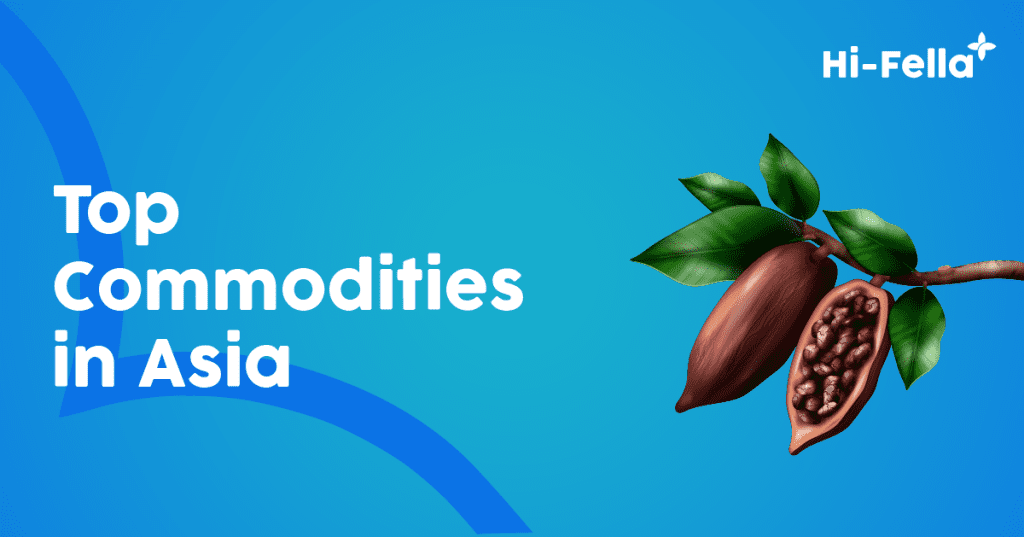Table of Contents
Investing in Asia’s thriving commodities market offers immense opportunities. Here, we look into the top commodities that drive the region’s economy and their investment potential, while also exploring the role of Hi-Fella in facilitating export-import activities.
Electronics
Asia’s dominance in the global electronics market is driven by a burgeoning middle class, cost-effective manufacturing capabilities, and a robust ecosystem of tech giants and semiconductor manufacturers. For investors seeking promising returns, exploring opportunities within this dynamic and rapidly evolving sector in Asia is a prudent choice. Asia has emerged as a tech powerhouse in the global electronics market, with countries like China and South Korea at the forefront of this transformation. This dominance can be attributed to several key factors.
First and foremost, Asia’s rapidly growing middle class has fueled an insatiable appetite for consumer electronics. As disposable incomes rise, more people in the region can afford smartphones, tablets, smart TVs, and other high-tech gadgets. This robust domestic demand serves as a solid foundation for the electronics industry’s growth.
China, in particular, has become a manufacturing hub for electronic devices. Its massive and skilled workforce, along with a well-established supply chain ecosystem, enables cost-effective production at scale. This advantage has led many tech giants, both domestic and foreign, to set up manufacturing operations in China.
Furthermore, Asia is home to some of the world’s largest and most innovative tech companies, such as Huawei, Samsung, and TSMC. These companies excel in various aspects of the electronics industry, from semiconductor manufacturing to telecommunications infrastructure. Their global influence and cutting-edge technology make them attractive investment options.
Semiconductor manufacturers, in particular, play a crucial role in the electronics ecosystem. South Korea’s Samsung and Taiwan’s TSMC are leaders in semiconductor fabrication, producing chips that power a wide range of devices, from smartphones to data centers.
Textiles
Asian textiles, blending tradition and modernity, continue to play a pivotal role in the global market. With countries like China, India, Bangladesh, and Vietnam leading the way, the industry is adapting to meet evolving demands while embracing sustainability as a driving force for future growth.. Asian textiles have a rich history steeped in tradition, with countries like China, India, and Japan being synonymous with the production of high-quality silk, cotton, and other fabrics for centuries. However, in today’s globalized world, Asian textiles have evolved to meet modern demands.
China is a textile production powerhouse, leading the world in both raw material production and textile exports. Its skilled workforce and efficient manufacturing processes have made it a dominant player in the global textile industry. In 2020, China’s textile and apparel exports amounted to approximately $291 billion.
India, known for its colorful and diverse textiles, has also adapted to modern demands by producing a wide range of fabrics for both domestic and international markets. The Indian textile and apparel industry accounted for around 13% of the country’s total export earnings in 2020.
Countries like Bangladesh and Vietnam have emerged as significant players in the textile industry due to their low labor costs and strong export-oriented manufacturing. Bangladesh, for instance, is the world’s second-largest apparel exporter, with exports valued at over $34 billion in 2020.
In recent years, sustainability has become a crucial focus in the Asian textile industry. Brands are increasingly adopting eco-friendly practices and using sustainable materials. This shift toward sustainability not only meets global consumer demands but also opens up new opportunities for eco-conscious textile manufacturing and brands in Asia.
Agriculture Products
Asia plays a pivotal role in global agriculture, contributing significantly to the world’s food basket. This vast and diverse continent is home to numerous countries that are major producers of essential agricultural commodities. Three key products, rice, tea, and rubber, exemplify Asia’s prominence in the agricultural sector.
- Rice: Asia is the epicenter of rice production, accounting for the lion’s share of the world’s rice output. Countries like China, India, Indonesia, Thailand, and Vietnam are major producers. For instance, China and India alone contribute to over half of global rice production. Rice is a staple in the diets of billions, and its cultivation sustains countless livelihoods.
- Tea: Asia, particularly countries like China, India, Sri Lanka, and Japan, is renowned for producing some of the finest teas globally. Tea is not only a popular beverage domestically but is also a significant export commodity. China and India are the largest producers of tea globally, with millions of people employed in tea cultivation and processing.
- Rubber: Asia dominates the global rubber industry, with countries like Thailand, Indonesia, Malaysia, and Vietnam being major rubber producers. Rubber is essential for various industries, including automotive and manufacturing, making it a critical commodity for both domestic consumption and international trade.
Investing in agribusinesses related to these commodities can be lucrative due to their consistent demand. Moreover, tracking commodity prices in these countries is essential for investors and businesses looking to capitalize on market trends. Asia’s influence in agriculture is undeniable, making it a focal point for anyone interested in the global food and agricultural sectors.
Asia boasts abundant natural resources, including minerals and energy sources. Investments in mining, renewable energy, and sustainable resource management are avenues for profit. These commodities are the lifeblood of many Asian economies. They drive exports, employment, and economic growth. Their stability influences regional economic health and global market dynamics. Tracking commodity trends, production, and consumption patterns is crucial. Government policies, trade agreements, and regulations can impact investments. Stay informed to make strategic decisions.
To guide this dynamic market, consider Hi-Fella. It’s a platform connecting buyers to sellers, simplifying export-import activities. Explore Hi-Fella.com for seamless trade experiences. Asia’s commodities market offers diverse investment prospects. Whether you’re eyeing electronics, textiles, agriculture, or natural resources, the region’s economic significance and Hi-Fella’s support make it an exciting destination for investors.








